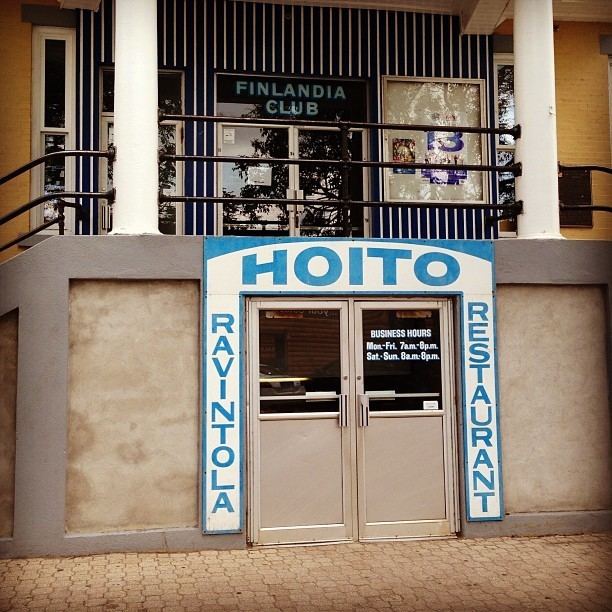Established 1918 (1918) Street address 314 Bay Street | ||
 | ||
The Hoito Restaurant (often referred to as “The Hoito” by locals) is a Finnish-Canadian restaurant in Thunder Bay, Ontario, Canada established in 1918 and housed in the bottom floor of the historic Finnish Labour Temple. The Hoito has operated continuously on 314 Bay Street, in the historic Bay & Algoma neighbourhood, for 98 years and is perhaps the oldest co-operatively owned and operated restaurant in Canada.
Contents
Beginnings
The name "Hoito" is Finnish for the word "care". The idea for the restaurant came about in a logging camp outside Nipigon, Ontario. IWW union organizer A.T. Hill had come to organize the camp into the union and promote the new Finnish-Canadian socialist newspaper Vapaus (Freedom). After winning some improvements in the camp, the workers expressed a concern that while being able to find cheap accommodation in the city of Port Arthur (now Thunder Bay), they were unable to find reasonably priced, home-cooked meals. The request to open a co-operative restaurant was taken to the board of directors of the Finnish Labour Temple and approved. 59 people pooled their money together in the form of 5-dollar “comrade loans”. Union organizer A.T. Hill was chosen as the restaurant’s first manager.
For several decades, workers in the restaurant belonged to the Industrial Workers of the World (IWW) union and later to the Canadan Teollisuusunionistinen Kannatusliitto (CTKL or Support League of Canadian Industrial Unionists), the Finnish section of the union, and not, as is often mistaken, to the Communist Party of Canada. The IWW was active in the bushcamps in Northwestern Ontario primarily among Finnish-Canadian bushworkers, and effectively operated as a radical alternative to their rivals in the communist-led unions. The Finnish Labour Temple itself was the Canadian administration for the IWW for a number of years.
When IWW organizer J. A. McDonald visited the Hoito and Finnish Labour Temple in 1926, "it was the activities of the women that he was most impressed by. According to McDonald all the waitresses were members of the IWW, and one of the cooks was a woman who had served a year in a Finnish prison for her activities on behalf of the Reds during the Finnish Revolution of 1918.".
Food
The Hoito Restaurant is best known for the delicious Finnish pancakes they serve to their customers. Thin and the size of a large dinner plate, they are eaten with maple syrup, strawberry sauce or a sprinkle of sugar. Known as lettu or lätty in Finnish, depending on what part of Finland one is from, they are one of the traditional Finnish foods served at the Hoito. Other items prepared include Viili (similar to yogurt), karjalanpiirakka, karjalanpaisti, lohiperunalaatikko, pulla, suolakala, riisipuuro, kalakeitto, hernekeitto and Nakki.
Another well-known dish is Mojakka, a stew of beef, potatoes and turnips that is seasoned with allspice. The word mojakka is not a Finnish word at all, but a term that was coined by the Hoito staff decades ago!
Co-operative restaurant
Since the restaurant began in 1918, it has operated as a consumer co-operative along Rochdale Principles. Customers can buy yearly membership cards that enable them to vote at the Finnish Labour Temple annual general membership meeting, where the board of directors is chosen for one to two year terms. Workers maintain a degree of workers' self-management and organize their own work schedules.
Customers
The Hoito is a popular place with locals in Thunder Bay, with line-ups for breakfast on Saturday and Sunday mornings. Clientele from all walks of life can be found at the Hoito, ranging from students and blue collar workers, to visiting celebrities, politicians and newsmakers.
Until the 1970s, the dining room featured long communal tables, and customers were able to buy meal tickets. Today, the restaurant operates in a more conventional way, with individual tables and several small communal tables.
